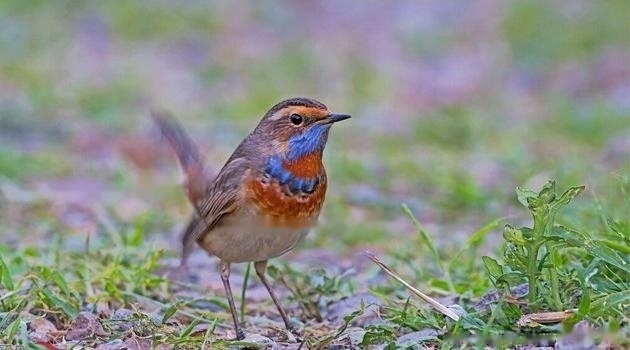Another name for blue indigo chin: blue-throated singing robin, blue-stalked reed bird, blue-chin, dotted chin, blue-indigo bar, etc. Indigo chin is a small bird species, its size is similar to that of a sparrow, and it is mainly distributed in China, Russia, Alaska, Iran, India, Asia, Europe, Africa and other regions. It is a very common bird species. Indigo Chin likes to chirp, and the chirping is very nice, just like singing, which is very interesting.

Body Type The indigo chin is very similar to the sparrow, very petite; the body length is generally 12-13cm. The weight is around 17-18g. The mouth is of moderate length and can catch food in very narrow places. The tail is very beautiful and very unique like a fan.
Feather characteristics The entire plumage of the chin is earthy brown, the eyebrows are white, and the tail is dark brown; The head and neck are blue. The underside of the thorax has two broad bands of black stripes and light chestnut, the abdomen is white, and the flanks and undertail coverts are brownish-white. Iris dark brown, bill black, feet brown.
Characteristics The indigo chin is shy, likes to run short distances on the ground, twisting the tail feathers or turning Tail feathers spread out. A little afraid of strangers, but able to adapt to new environments quickly.
Indigo chin likes to perch in shrubs and reeds, like to hide Under the bush, the flight is very low, mainly for better foraging. Generally, the blue indigo chin is only used for short-distance flying, and likes to run on the ground. It can also imitate the sound of insects. It mainly feeds on beetles, stink bugs, locusts, Lepidoptera, Coleoptera and other insects, especially the natural food of Lepidoptera, as well as seeds and buds. The indigo chin breeding season is around May-August. Before breeding, they will build their own nests, usually in the bushes or reeds. Usually, a clutch of 4-7 eggs is laid, and the incubation period is 13-15 days. It belongs to the late bloomers of chicks, and usually can grow feathers after 14-15 days. Artificial breeding requires more careful care from the owner.
feed The owner should pay attention to the freshness when feeding the food, and cannot feed expired food. Natural foods include: insects, nuts, fruits, buds, etc. Artificially configured feed is also possible, but the main thing is to pay attention to nutritional matching.
Light The blue-spotted chin is more lively and active. Get some fresh air and get some sunshine. In summer, you can also let the blue indigo chin water bath. The temperature of the bath water should be between 25 ° C and 35 ° C. During the moulting period, special attention should be paid to giving more live food and other animal feeds.
The price of indigo chin is generally around a few yuan to dozens of yuan. It will be affected by the size, shape, gender and flexibility of the indigo chin, and the price will also vary in different regions.
![[Dog Training 5] The training method of pet dog dining etiquette](/static/img/12192/12192_1.jpg)




